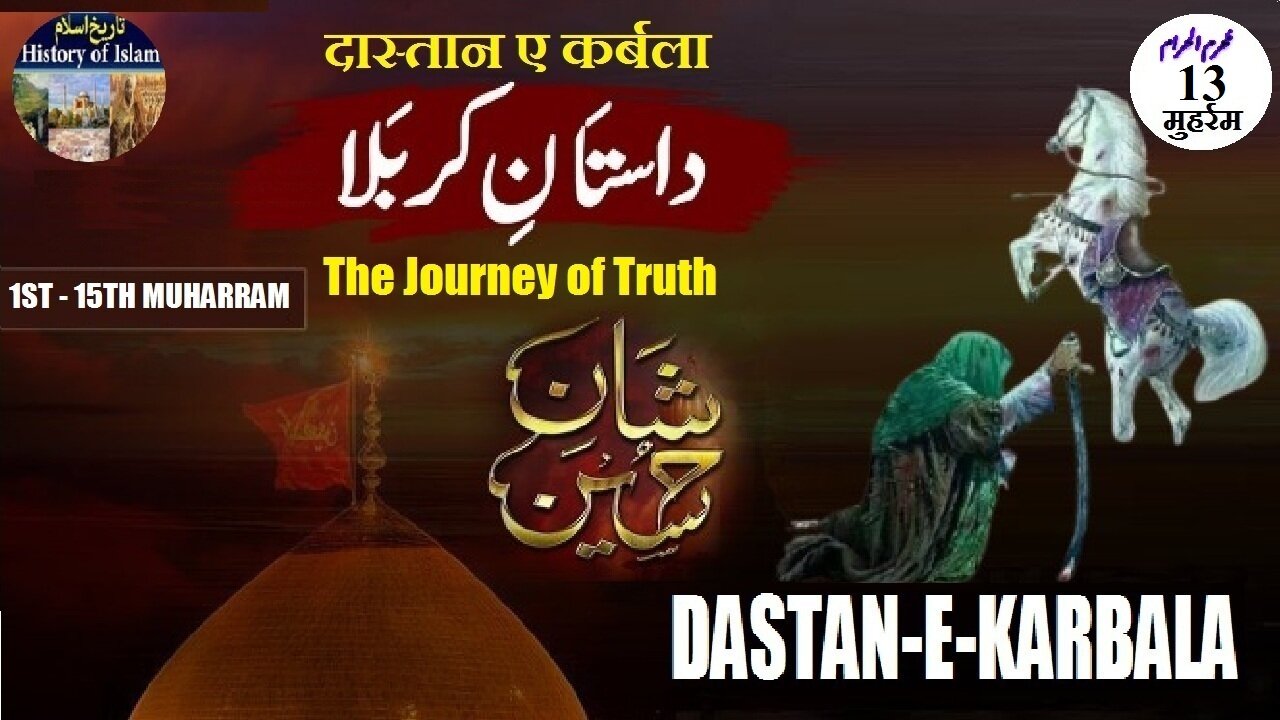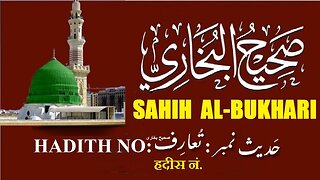Premium Only Content

13th Muharram Dastan-e-Karbala मुहर्रम दास्तान-ए-कर्बला تیرہویں محرم الحرام داستانِ کربلا
@islamichistory813 #muharramalahram #muharram #karbala #dastanekarbala #journeyoftruth #imamhussain #ashura #shia #history #islamic #martyrs #karbala #story #hussain #islamic #sacrifice #shia #commemoration #karbala #lessons #1st #to 15th #muharram #truthofkarbala
13th Muharram Dastan-e-Karbala The Journey of Truth
Asslamoalaikum, The tragedy of Karbala is one of the most heart-wrenching and powerful chapters in Islamic history. Occurring in the sacred month of Muharram, this historic event marks the ultimate sacrifice of Imam Hussain (RA), the beloved grandson of Prophet Muhammad (SAW), who stood fearlessly against tyranny and injustice. On the plains of Karbala, in 61 AH (680 CE), Imam Hussain, along with his family and a small group of loyal companions, faced the brutal army of Yazid. Denied water, surrounded by enemies, and offered no escape, they chose martyrdom over surrender, preserving the values of truth, justice, and faith.
This video takes you through the sorrowful yet inspiring journey of Karbala—each day of Muharram carrying profound pain and unmatched bravery. From the departure of Imam Hussain from Madinah to the heart-shaking events of Ashura, we honor the legacy of those who gave their lives for Islam.
So sisters brothers friends and elders today we will be the described events of 13th Muharram in this video.
The 13th of Muharram dawned upon Karbala as a day of somber silence and grief, with the dust of tragedy still fresh over the sacred land. The aftermath of the massacre on the 10th of Muharram had left the plains soaked in the blood of the Prophet’s beloved family and companions. On this day, the reality of the atrocity committed against **Imam Hussain (A.S)** and his supporters settled heavily over the hearts of those who truly recognized what had transpired. While the **Ahlul Bayt (A.S)** were now prisoners being taken towards Kufa in chains and humiliation, the land of Karbala still bore the weight of the bodies of martyrs, some of whom had only just been buried on the 12th of Muharram by the noble tribe of **Banu Asad**, with the help and guidance of **Imam Zain-ul-Abideen (A.S)**.
The 13th of Muharram is especially significant because it is narrated that the **last rites and burials were completed** by this day. While most of the martyrs had been laid to rest the previous day in haste and secrecy, the remaining ones were buried with as much honor as the conditions allowed. The pain of not being able to give a proper burial immediately after martyrdom was a deep wound for the followers of Ahlul Bayt, as Islamic tradition holds immense respect for the prompt and dignified burial of the deceased. Yet, the cruelty of Yazid’s army had left the bodies exposed for days under the burning sun, as a display of intimidation and oppression. The **headless body of Imam Hussain (A.S)** was placed in its grave, while his blessed head had already been taken away by the enemy to be paraded before tyrants in Kufa and later Damascus.
As the dust settled on the battlefield, the graves of the martyrs became a symbol of resistance and truth. Though simple and unmarked in those days, these graves would one day become sacred shrines visited by millions of believers who would bow in humility before the memory of those who stood for Islam with their lives. The land that had witnessed one of the greatest injustices in human history was slowly transforming into a **land of spiritual awakening**, where hearts would forever remember the cries of “Al-Atash!” from thirsty children, the roars of courage from the companions, and the unshakable stand of **Hussain (A.S)** in the face of overwhelming oppression.
Meanwhile, on the 13th of Muharram, the **caravan of captives**, including the women and children of Ahlul Bayt, continued its sorrowful journey under the harsh guard of Yazid’s soldiers. The heads of the martyrs, raised on spears, were carried ahead of them, including that of **Imam Hussain (A.S)**, whose glowing face still radiated with the light of martyrdom. The women, led by **Lady Zainab (S.A)** and accompanied by the ailing **Imam Zain-ul-Abideen (A.S)**, bore their pain with incredible patience. Their journey was not one of defeat, but of purpose. They were not merely captives; they were the **bearers of Hussain’s message**, the living testament of Karbala’s truth.
During this day, sorrow spread among those in Kufa who had once admired Imam Hussain (A.S) but had remained silent out of fear. As the news of the massacre and the treatment of the Prophet’s family began to circulate, regret and shame began to stir in many hearts. Some wept at the sight of the captives. Others hung their heads in guilt, realizing too late that they had remained passive during a moment when standing for truth was a duty. The **13th of Muharram**, therefore, became a day of reflection — not just for those who witnessed the aftermath, but for generations to come.
Karbala was no longer just a battlefield. It had become a **divine revolution**, where the blood of the martyrs watered the tree of justice, and the grief of the survivors carried the eternal message: **“Every day is Ashura, and every land is Karbala.”** The 13th of Muharram marked the end of the massacre, but it was the beginning of a movement that would live on in the hearts of all who stand against oppression.
As we remember the heartbreaking events of Karbala, let us not only remember the sacrifices of Imam Hussain (RA) and his companions, but also strive to embody their values ??of truth, justice, and unwavering faith. Their legacy is a timeless reminder that standing up against oppression is the duty of every believer. May their courage inspire us to live with dignity and righteousness. Amen.
Allah Hafiz
=========================
-
 6:58
6:58
ISLAMIC HISTORY
1 day agoIntroducion Hadith Nabwi | Sahih Al-Bukhari | Ilm aur Noor ki Raahain | تعارف حدیث نبوی صحیح البخاری
6 -
 LIVE
LIVE
Akademiks
5 hours agoWHERE IS WHAM????? Thug we Forgive u dawg.. Ralo vs Boosie. Charlie Kirk fallout. Cardi B album?
2,828 watching -
 2:05:53
2:05:53
Inverted World Live
6 hours agoDeath Cult Terror Cells, NASA Bans Chinese Nationals | Ep. 108
59.6K9 -
 2:43:57
2:43:57
TimcastIRL
7 hours agoVP Says No Unity With Democrats Celebrating Charlie Kirk Assassination, Left Confirmed | Timcast IRL
274K178 -
 13:45
13:45
The Charlie Kirk Show
6 hours agoTPUSA AT ASU CANDLELIGHT VIGIL
221K66 -
 55:10
55:10
Katie Miller Pod
6 hours ago $12.67 earnedEpisode 6 - Attorney General Pam Bondi | The Katie Miller Podcast
92.4K27 -
 1:46:41
1:46:41
Man in America
11 hours agoLIVE: Assassin Story DOESN'T ADD UP! What Are They HIDING From Us?? | LET'S TALK
73.2K98 -
 2:24:17
2:24:17
Barry Cunningham
7 hours agoFOR PRESIDENT TRUMP WILL TAKE NO PRISONERS AND THE LIBS SHOULD EXPECT NO MERCY!
109K66 -
 1:08:41
1:08:41
Savanah Hernandez
8 hours agoCharlie Kirk Was Our Bridge And The Left Burned It
59.2K53 -
 1:59:01
1:59:01
Flyover Conservatives
10 hours agoFinancial Web Behind Charlie Kirk's Murder with Mel K | Silver On It's Way to $50 | FOC Show
68.9K5